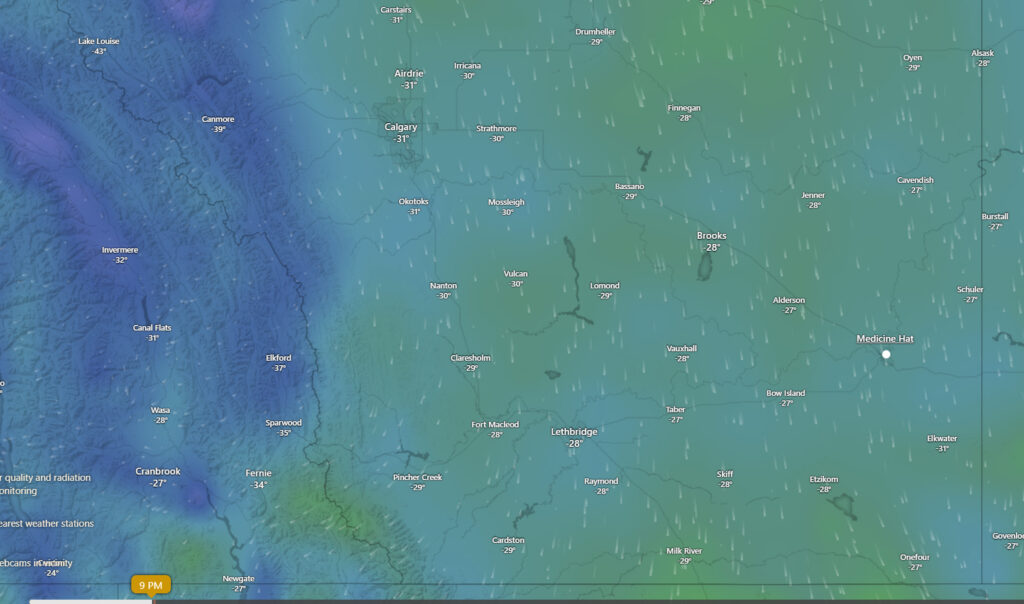Brian Zinchuk is editor and owner of Pipeline Online

As cold temperatures descended upon Alberta’s wind generating assets, you could identify when they shut down due to the temperature, as shown in red. That’s a lot of red, across the 45 wind farms in Alberta. Dispatcho.app,
UPDATE: By 7:28 a.m., wind output fell to less than 1 per cent of capacity
One of the first lessons any new engineering student learns in their materials class is “cold brittle behaviour” of materials. When it gets really cold, like -30 C or colder, many materials lose much of their strength and are prone to shattering. This applies to wind turbines as much as it applies to car bumpers.
And as a result, most wind turbines are shut down when the ambient temperatures reaches around -30 C, lest their continued operation cause them to shatter. And such shutdowns were plainly evident the evening of Jan. 11, on both the Alberta Electric System Operator website and on Dispatcho.app. That’s a website that logs the minute-by-minute data published by the AESO regarding the Alberta electrical grid.
The screenshot above was captured at approximately 11 p.m., Thursday, Jan. 11. Temperatures were in the -28 to -30 C range for most of the areas of southern Alberta where the province’s 45 wind farms are located, according to Windy.com. That website is also very useful in showing windspeed and direction. And Windy.com showed that it wasn’t for lack of wind those farms were shutting down. Nearly every location still had 7 to 9 knots of wind. That’s not a lot, but it’s not nothing, either.

This screenshot from Windy.com at 11 p.m., Jan. 11, showed wind vectors and temperatures in southern Alberta, where nearly all of the province’s grid-scale wind generation is located. Windy.com
That was clearly indicated by Blackspring Ridge, which all by itself was providing roughly half of the roughly 400 megawatts of wind power in Alberta at the time. Located near Lethbridge, it was producing roughly two-thirds of its nameplate capacity, despite wind speeds of 7 knots and gusts up to 16 knots at Lethbridge, while the temperature was -28 C. Stirling Wind, on the other side of Lethbridge, was producing 47 megawatts just a few hours earlier, before dropping to 2 megawatts at 9 p.m.
In the hour that followed, Blackspring Ridge, too, appeared to be spinning down in a linear fashion, producing 79 megawatts at 12:15 a.m. And at 7:28 a.m., it was at one megawatt.
At this moment 91.1% of Alberta's electricity is being produced by fossil fuels. Wind is at 8.9% of capacity and producing 3.5% of total generation, while solar is at 0.1% of capacity and producing 0.01% of total generation. At the same time we are importing 258 MW or 2% pic.twitter.com/CO9rdb0KCl
— Reliable AB Energy (@ReliableAB) January 12, 2024
As all of this was taking place, the pool price for Alberta flowed around the $450 to $667 range. There was a sharp uptick in prices at 5 p.m., as demand was peaking and wind assets were increasingly going offline.
Wind output continued to fall throughout the night. As the workforce was warming up its morning breakfast and coffee, wind power generation had fallen to 37 megawatts out of an installed capacity of 4,481 megawatts. That’s 0.8 per cent, or eight one-thousandths of nameplate capacity, on one of the coldest days of the year, produced by hundreds of wind turbines across 45 wind farms costing billions of dollars.
By this point, temperatures across southern Alberta had fallen to -31 C in most locations, but wind was still 7-9 knots in most wind-producing locations, according to Windy.com.
And since the sun had yet to rise, solar output was zero, out of 1,650 megawatts.
And power pool prices were expected to spike throughout the day, according to X bot account @ReliableAB.
At this moment 93.9% of Alberta's electricity is being produced by fossil fuels. Wind is at 0.8% of capacity and producing 0.3% of total generation, while solar is at 0.0% of capacity and producing 0.00% of total generation. At the same time we are importing 488 MW or 4% pic.twitter.com/H4NeGHyiI9
— Reliable AB Energy (@ReliableAB) January 12, 2024
It also turns out Alberta set a record for peak demand on Jan. 11, according to the AESO:
Demand for electricity in Alberta hit a new hourly peak of 12,384 megawatts on Thursday, January 11, 2024, as extreme cold weather blanketed the province. Stay warm and check out our electricity conservation tips: https://t.co/H3xXXvV4Ou pic.twitter.com/iehTcsQcOx
— AESO (@theAESO) January 12, 2024
White knight
There may soon be a white knight to the rescue, however, in terms of a massive new power combined cycle natural gas-fired station with two 450 megawatt generating units coming online for a total of 900 megawatts that will be both baseload and dispatchable. The Globe and Mail wrote about it here.
As described by Dispatcho.app, “Cascade 1 (CAS1) is a 450 MW natural gas combined cycle generator located in Yellowhead County, approximately 12 KM southwest of Edson, AB. This asset is located at the same facility as Cascade 2, which together cost ~$1.5B to build, and was connected to the grid in 2023. The facility is comprised of two Siemens SCC6-8000H gas turbines for a combined generation capacity of 900 MW. These turbines are designed for short start-up and ramp times which will help ensure a stable power grid in Alberta. This asset is owned by Kineticor.”
Cascade Unit 1 is still in startup phase, as Kineticor announced on LinkedIn on Jan. 10, “We are thrilled to announce that the Cascade Power Project has successfully delivered its first megawatt onto the Alberta Power Grid!”
However, the evening of Jan. 11, the AESO was showing Cascade Units 1 and 2 were not providing power at that time.
Meanwhile in Saskatchewan
In Saskatchewan, it was getting pretty cold as well, and it showed up in SaskPower’s grid demand webpage. At 7 p.m., that monitor showed SaskPower’s hourly average usage was 3,760 megawatts, just 150 megawatts shy of the all-time record established two years earlier, on Dec. 30, 2021. That, too, was a very cold night.
